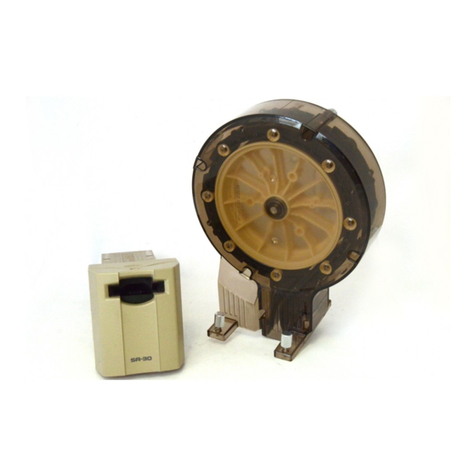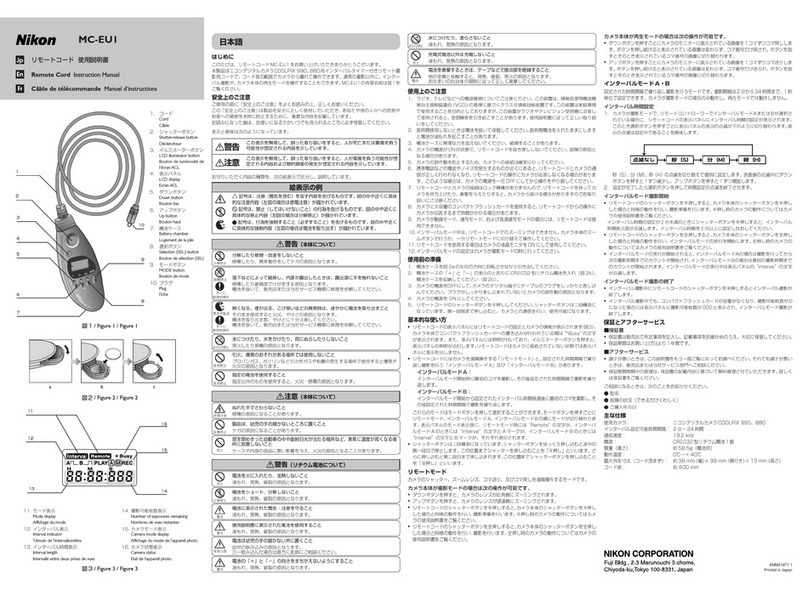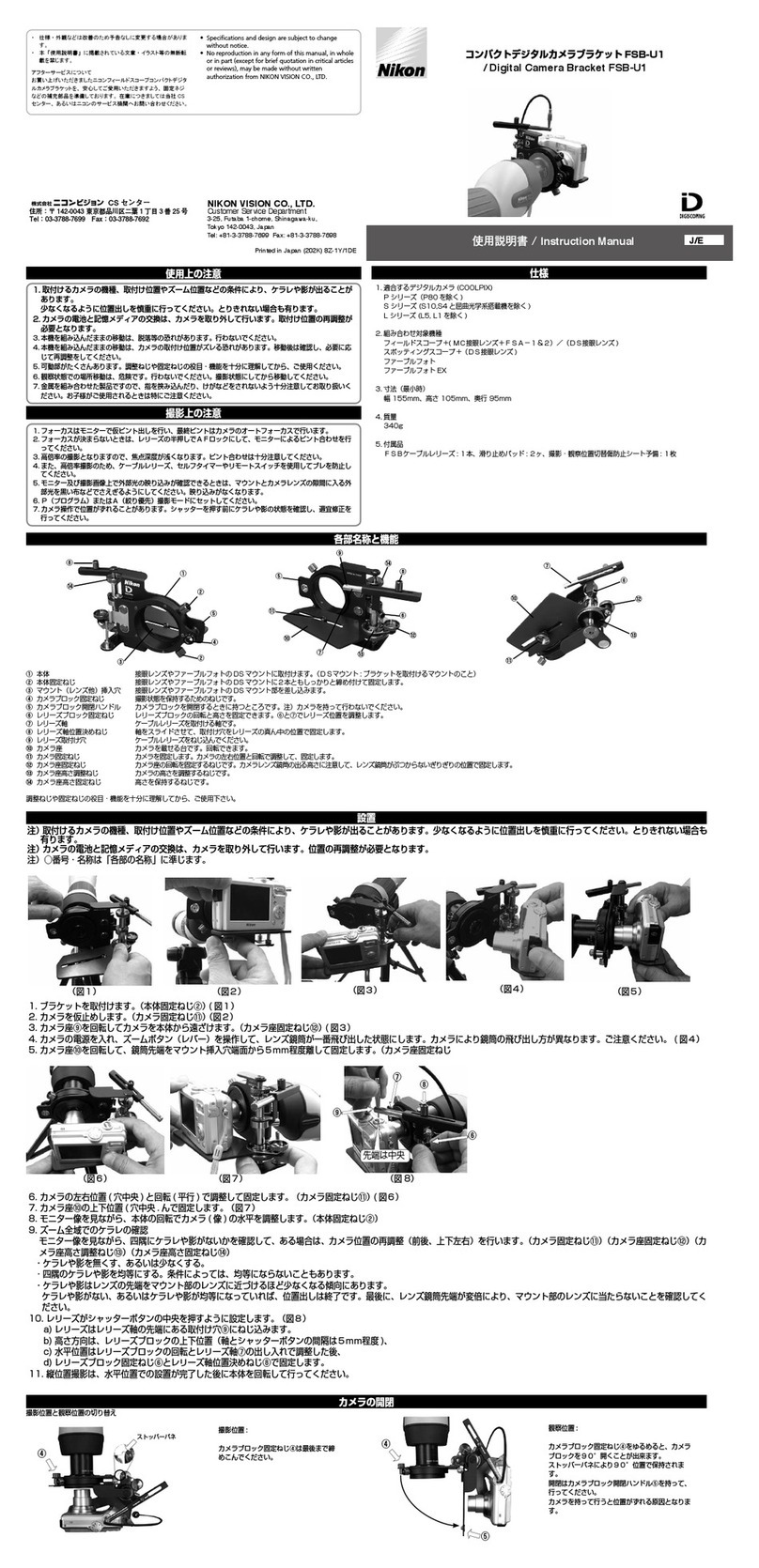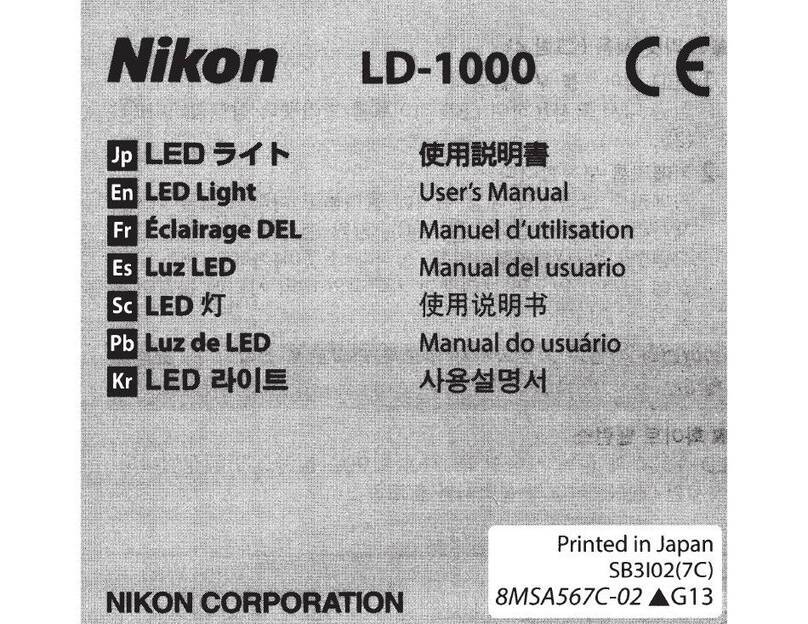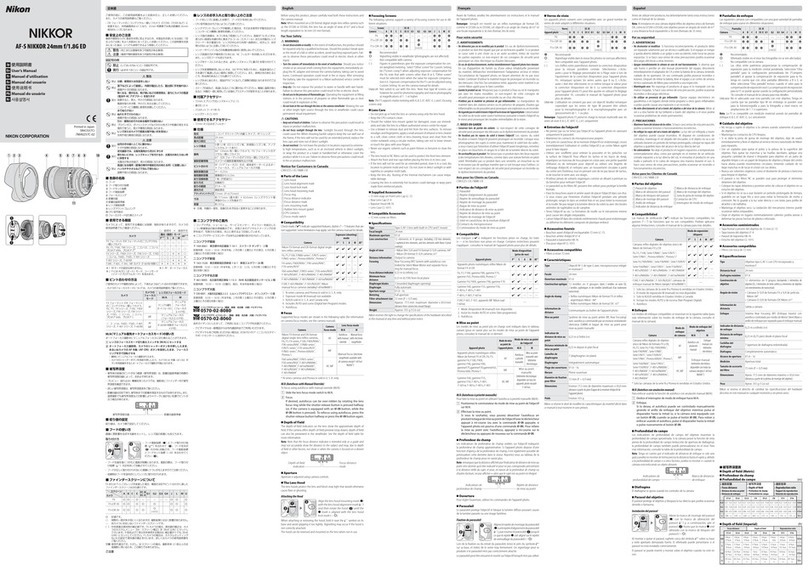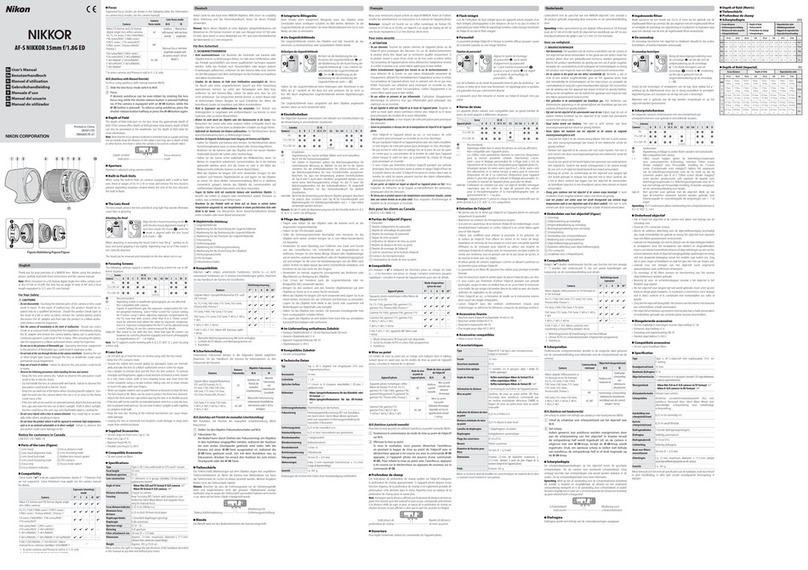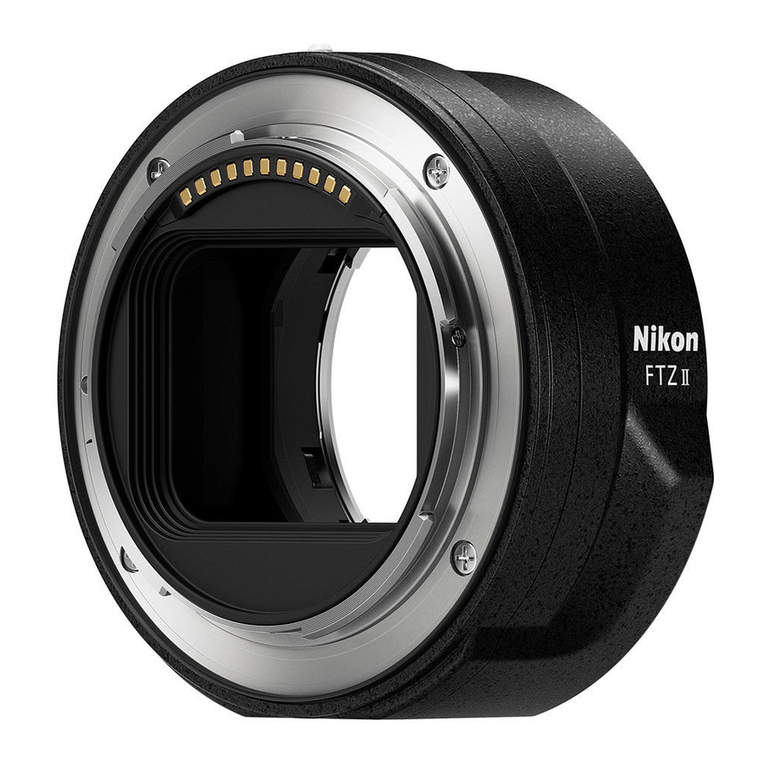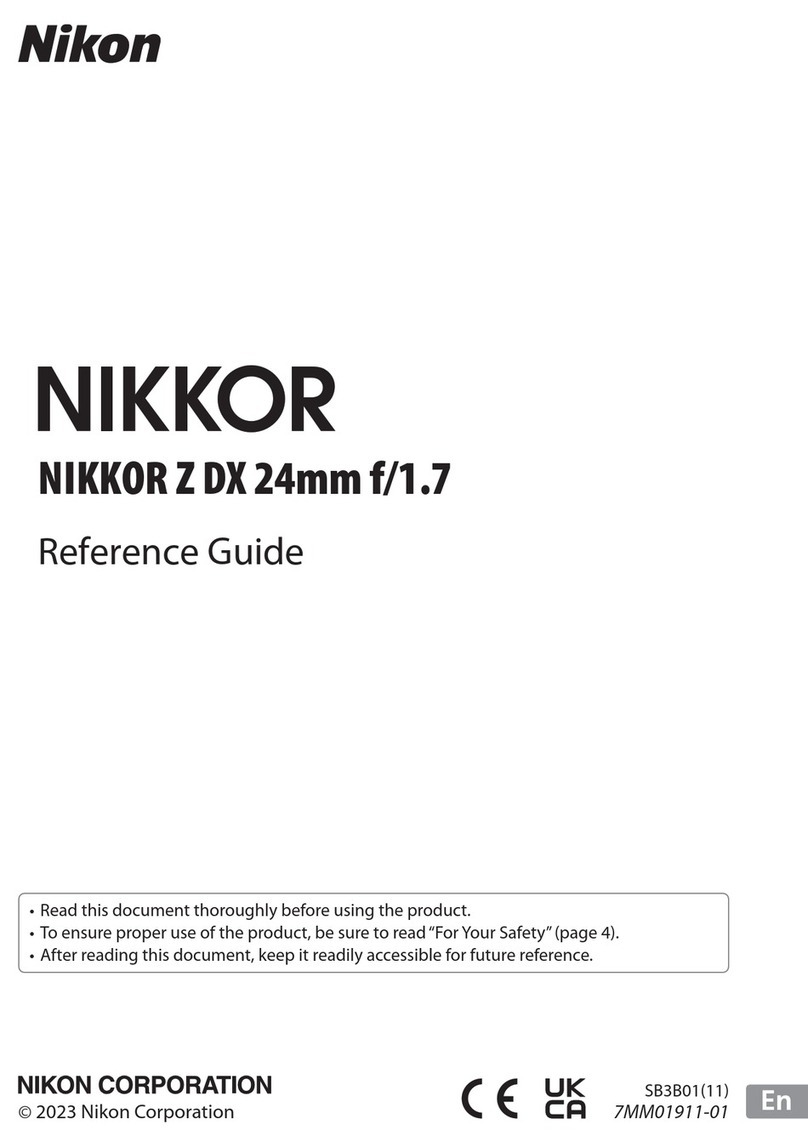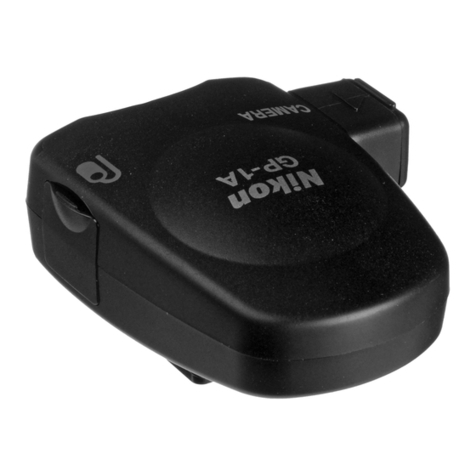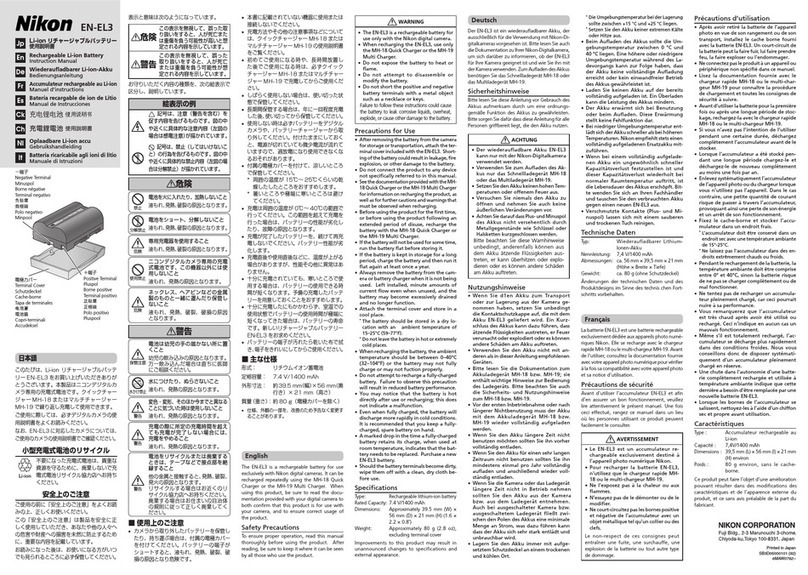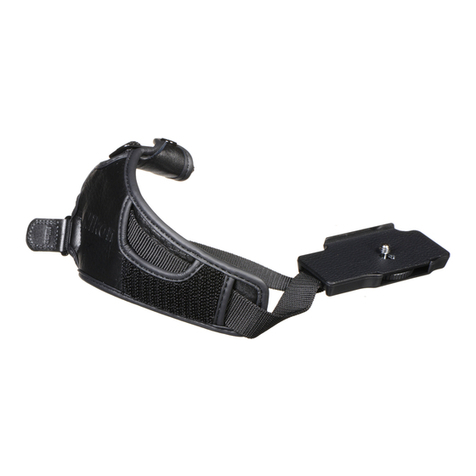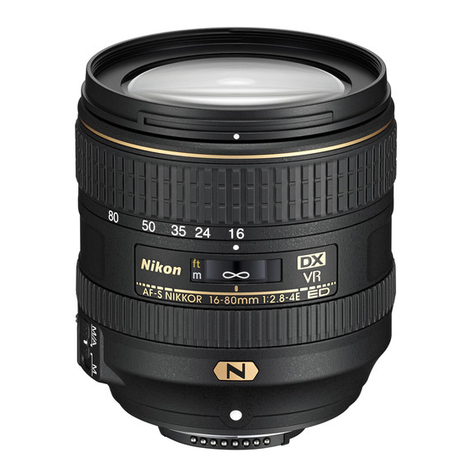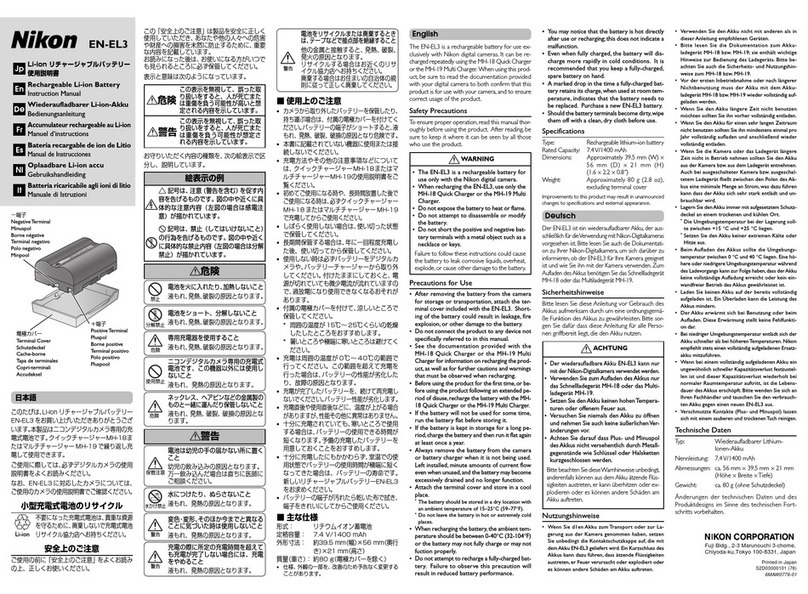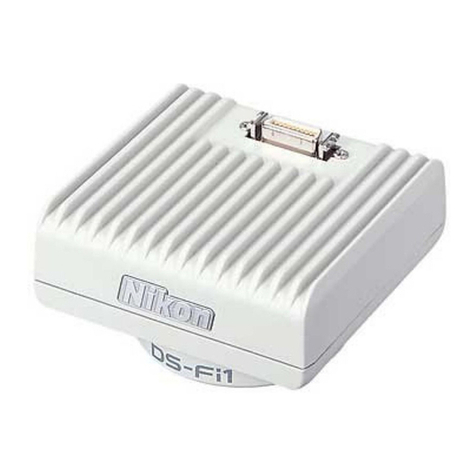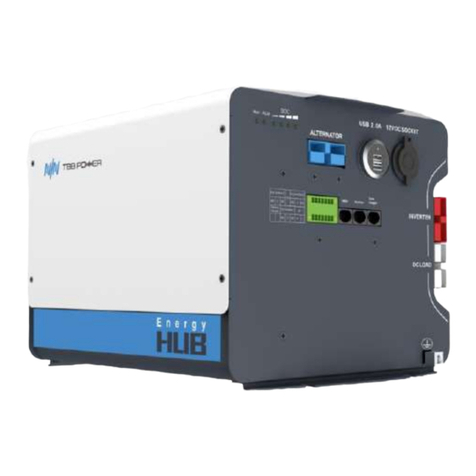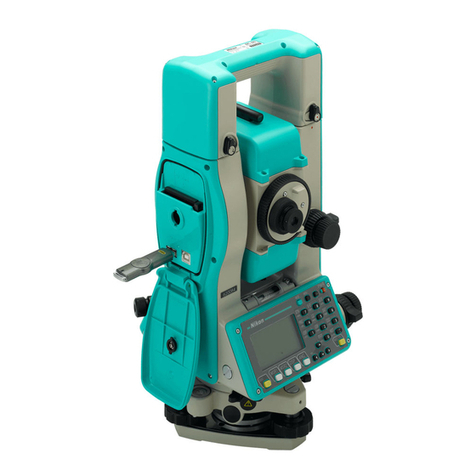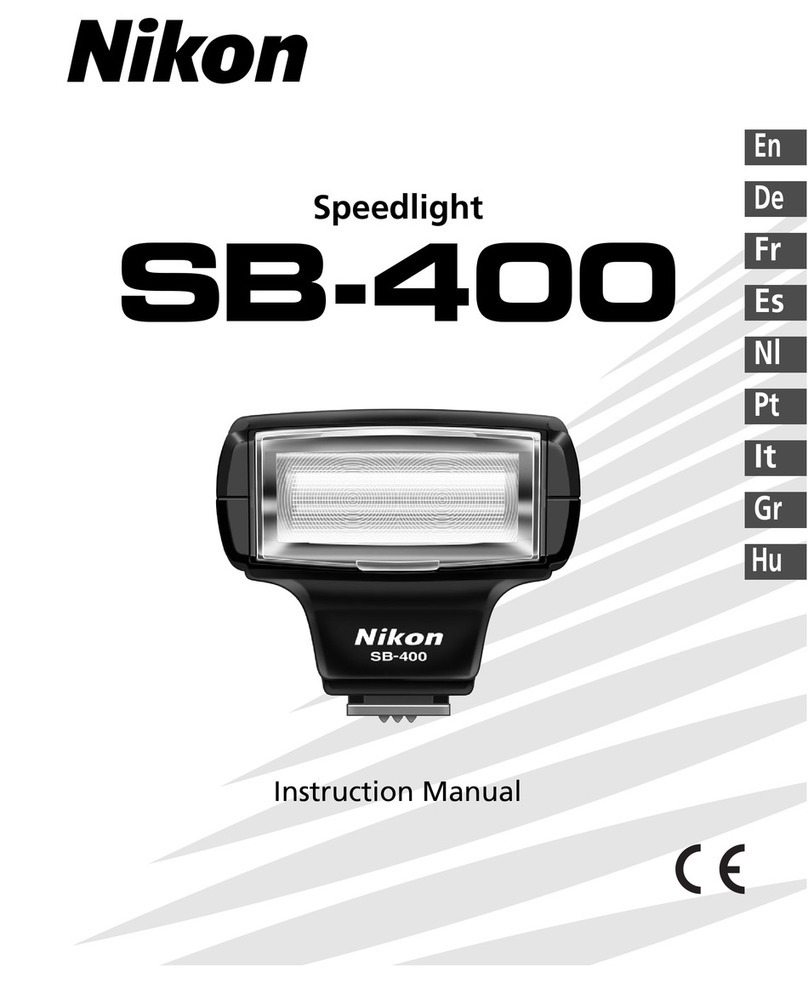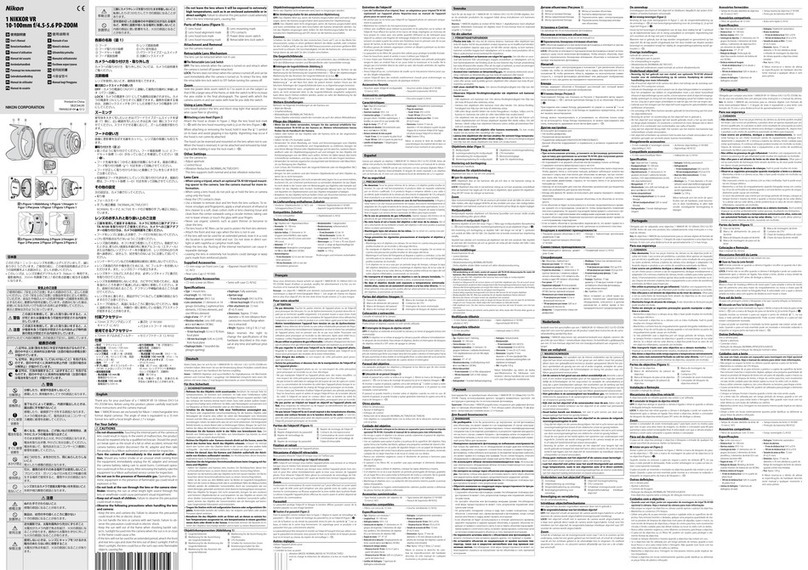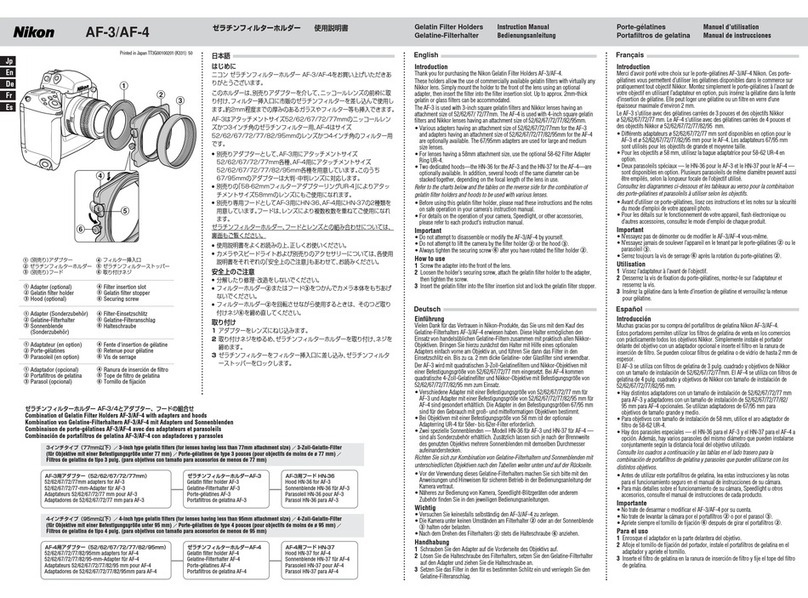Français
Español
Italiano
Nous vous remercions pour votre achat de ce filtre Nikon. Veuillez lire
attentivement ce mode d’emploi pour pouvoir utiliser correctement votre
nouveau filtre.
Caractéristiques
Ces filtres polarisants circularires sont conçus pour être utilisés avec des
téléobjectifs équipés d’un support à filtre de type à insertion, et réduire
l’éblouissement dû à des surfaces non-métalliques, telles que le verre ou
l’eau. Autres caractérisques de ces filtres:
• Prévention des erreurs de mise au point/mesure survenant avec les
boîtiers AF dotés de filtres polarisants ordinaires
• Efficaces à la fois en photographie couleur et monochrome
• Peuvent aussi s’utiliser avec des boîtiers non-AF.
Objectifs utilisables
Voir le tableau des Objectifs utilisables pour les informations sur les types
d’objectif pouvant être utilisés avec ces filtres. Reportez-vous aussi au
manuel d’instructions fourni avec votre objectif.
Avantages
1. Photographie de sujets réfléchissants
La lumière réfléchie par des surfaces lisses, telles que verre, plastique
brillant, céramique, carreaux, bois, papier ou eau est généralement polarisée.
La réduction ou le blocage de cette lumière réfléchie avec un filtre polarisant
circulaire permet d’obtenir des images plus réalistes et plus intéressantes du
sujet. (Note: Ces filtres ne sont pas efficaces contre la lumière réfléchie par
des surfaces métalliques.)
2. Photographie du ciel bleu
Un ciel bleu se compose de lumière du soleil dispersée, et est normalement
polarisé. L’emploi d’un filtre polarisant circulaire permet de bloquer la
lumière réfléchie par la vapeur ou les particules de poussière minuscules en
suspension dans l’air, rendant le ciel bleu encore plus blue. En photographie
monochrome, il est également possible d’accentuer le sujet en fonçant les
tons du ciel sans augmenter le contraste du reste de l’image. En
photographie couleur, les couleurs peu naturelles dues à la réflexion de la
lumière solaire peuvent être éliminées. Ces filtres sont particulièrement
efficases pour la photographie d’un ciel blue à angle droit par rapport au
soleil, à savoir si vous prenez le ciel juste au-dessus de l’horizon quand le
soleil au-dessus de vous, ou si vous prenez le ciel directement au-dessus de
votre tête au lever ou au coucher du soleil.
Installation (Fig. A)
Remplacez le support à filtre en place dans l’objectif par le support à filtre
polarisant circulaire souhaité.
1Vérifiez que l’index de montage sur le bouton du support à filtre
polarisant circulaire est parallèle au filtre.
2Insérez le support à filtre polarisant circulaire dans la fente à filtre. La
flèche à l’indication “FRONT” sur le support doivent être dirigées
vers l’avant de l’objectif.
3Pressez le bouton du support et tournez-le de 90° dans le sens horaire
de sorte que l’index de montage du bouton soit à angle droit avec le
filtre.
Insérez fermement le support à filtre dans l’objectif. Notez que la
baie du filtre n’est pas étanche à la poussière et à l’eau.
Utilisation du filtre (Fig. B)
Avant de prendre une photo, tournez la bague rotative du filtre polarisant
circulaire tout en regardant l’image dans le viseur. Recherchez la position la
plus efficase pour réduire la lumière réfléchie.
Une légère différence de couleur peut être perceptible dans le
viseur à la rotation du filtre, mmais cela n’affectera pas la
photographie.
Remarques sur l’utilisation
• Utilisez la mesure à pondération centrale. La mesure multi-capteur peut
provoquer une exposition incorrecte.
• A l’usage d’un boîtier à mesure d’exposition non-TTL, une certaine
correction de l’exposition est requise. Le facteur d’exposition variera
selon l’angle de prise de vue par rapport à la surface réfléchissante du
sujet, à la longuer d’onde de la lumière, à la sensibilité couleur du film, et
à d’autres facteurs. Mais, un facteur de 2 à 4 (+1 à +2 valeurs/f) est
normalement suffisant.
• Ne rangez pas le filtre à un emplacement très chaud, humide ou en plein
soleil.
Agradecemos la adquisción del filtro Nikon. Con el fin de usar correctamente
su nuevo filtro, se ruega leer enteramente este manual de instrucciones.
Características
Estos filtros polarizadores circulares están diseñados para el uso en
combinación con los teleobjetivos con el portafiltro insertable para reducir el
resplandor de las superficies no metálicas como el vidrio y el agua. Entre
otras características del filtro se citan:
• Previene los errores de enfoque/medición que ocurren al usar las cámaras
tipo AF (autoenfoque) provisas con filtros polarizadores regulares.
• Es eficaz tanto para las fotografías de color como monocromáticas.
• Pueden usarse también en las cámaras que no sean AF.
Objetivos aplicables
Con respecto a la información de los tipos de objetivos que pueden usarse
con estos filtros, se ruega ver la Tabla de Objetivos Aplicables. Consulte
también el manual de instrucciones proporcionado con su objetivo.
Ventajas
1. Fotografiado de objetos reflectivos
Las luces reflejadas de las superficies lisas como el vidrio, plásticos
brillantes, cerámicas, azulejos, maderas, papel o agua son normalmente
polarizadas. Mediante la reducción o el bloqueo de estas luces refljadas con
el filtro de polarización circular, podrán crear imágenes más realistas y
atractivas del objeto. (Nota: Esto filtros no son eficaces contra las luces que
provienen de superficies metálicas.)
2. Fotografiado del cielo azul
El cielo azul se compone de la luz solar dispersa y es normalmente
polarizado. Con el filtro polarizador circular, es posible bloquear la luz
reflejada por el vapor o pequeñas partículas de polvo en suspensión en el
aire, haciendo que el cielo azul se vea más azulado. En las fotografías
monocromáticas, podrán también acentuar el objeto fotográfico mediante la
intensificación del tono del cielo sin incrementar el contraste del resto de la
fotografía. En la fotografía de colores, pueden eliminar los colores
innaturales causados por la luz solar reflejada. Estos filtros son
especialmente eficaces para fotografiar el cielo azul en ángulo recto con
respecto a la dirección de la luz solar, o sea apuntando el cielo justo sobre el
horizonte cuando el sol estuviera directamente encima suyo o apuntando
directamente el cielo sobre la cabeza con el sol naciente o poniente.
Instalación (Fig. A)
Reemplazar el portafiltro que se encuentra insertado en el objetivo con el
portafiltro polarizador circular deseado.
1 Para el portafiltro polarizador circular, deberá verificarse que el índice
de guía de montaje de la perilla est paralelo con el filtro.
2 Insertar el portafiltro polarizador circular en la ranura del filtro
orientando a la flecha de la indicación “FRONT” hacia el
extremo frontal del objetivo.
3 Pulsar la perilla del portafiltro y girar 90° en el sentido de las agujas del
reloj, de manera que el índice de guía de montaje de la perilla quede en
ángulo recto con respecto al filtro.
La fijación en el objetivo debe realizarse con seguridad. Se hace
notar que el alojamiento del filtro no tiene una construcción a
prueba del polvo ni a prueba de agua.
Uso del filtro (Fig. B)
Antes de tomar la fotografía, girar el anillo rotativo del filtro polarizador
circular observando la imagen del visor. Buscar la posición que sea más
eficaz para la reducción de las luces reflejadas.
Al girarse el filtro, podrá notarse en el visor una ligera diferencia
de color, pero esto no afectará la fotografía.
Notas sobre el uso
• Se ruega usar la medición concentrada en el centro, debido a que la
medición de sensores múltiples podrá causar la exposición incorrecta.
• Cuando se utilice una cámara con fotómetro que no sea del tipo TTL (a
través del objetivo), se requerirá alguna compensación de exposición. El
factor de exposición variará según el ángulo de fotografiado relativo a la
superficie reflectante del objeto, la longitud de onda de la luz, la
sensibilidad del color de la película y otros factores. Sin embargo,
normalmente será suficiente con un factor de 2 a 4 (+1 a +2 de la escala
del diafragma).
• No guardar el filtro en lugares expuestos a la alta temperatura, alta
humedad o la luz solar directa.
Grazie per aver acquistato un filtro Nikon.
Per un uso corretto del prodotto, leggere attentamente il manuale d’istruzioni.
Caratteristiche
Questi filtri polarizzatori circolari sono stati progettati per essere utilizzati
unitamente ai teleobiettivi dotati di portafiltri scorrevole, quindi sono in
grado di ridurre il riflesso creato dalle superfici non metalliche tipo vetro e
acqua. Tra le altre caratteristiche del filtro:
• Prevenzione contro eventuali errori di messa a fuoco/misurazione in caso
di utilizzo di fotocamere AF dotate di normali filtri polarizzatori.
• Perfetti sia per la fotografia a colori sia per quella monocromatica.
• Possono essere utilizzati anche con le fotocamere non AF
Obiettivi utilizzabili
Per informazioni circa i tipi di obiettivo che possono essere utilizzati con
questi filtri, fare riferimento alla relativa tabella. Inoltre, fare riferimento al
manuale d’istruzioni fornito in dotazione.
Vantaggi
1. Fotografare i soggetti riflettenti
Le superfici lisce che riflettono la luce tipo vetro, plastica lucida, ceramica,
smalto, legno, carta o acqua solitamente sono polarizzate. Riducendo o
bloccando questa luce riflessa mediante filtro polarizzatore circolare, è
possibile creare riproduzioni del soggetto più realistiche e belle. (Nota:
Questi filtri non hanno efficacia contro la luce riflessa dalle superfici
metalliche).
2. Fotografare l’azzurro del cielo
Il cielo, composto da luce solare dispersa, viene normalmente polarizzato.
Con un filtro polarizzatore circolare, è possibile bloccare la luce riflessa dal
vapore disperso nell’aria o dalle minuscole particelle di polvere, in modo tale
che il cielo sembri persino più azzurro. Nella fotografia monocromatica, è
possibile inoltre accentuare il soggetto fotografico scurendo i toni del cielo,
senza aumentare il contrasto nel resto della foto. Nella fotografia a colori, i
colori non naturali causati dalla luce del sole riflessa vengono eliminati.
Questi filtri sono efficaci soprattutto quando si fotografa un cielo azzurro ad
angolo retto rispetto al sole, cioè riprendendo il cielo appena sopra
l’orizzonte quando il sole si trova sopra di voi, oppure riprendendo il cielo
direttamente da sopra la propria testa all’alba o al tramonto.
Installazione (Fig. A)
Sostituire il portafiltri attuale inserito nell’obiettivo con il portafiltri
polarizzatore circolare desiderato.
1Con il portafiltri polarizzatore circolare, verificare che l’indicatore per il
montaggio sulla relativa manopola sia parallelo al filtro.
2Inserire il filtro polarizzatore circolare nello slot del filtro. La freccia con
indicazione “FRONT” dovrebbe essere puntata verso la parte
anteriore dell’obiettivo.
3Spingere la manopola del portafiltri verso il basso e ruotarla in senso
orario di 90° in modo tale che l’indicatore per il montaggio sia ad
angolo retto rispetto al filtro.
Posizionare saldamente il portafiltri sull’obiettivo. Tenere presente
che il vano filtro non è antipolvere né impermeabile.
Utilizzo del filtro (Fig. B)
Prima di scattare una fotografia, ruotare l’anello del filtro polarizzatore
circolare mentre si guarda l’immagine nel mirino. Trovare la posizione più
adatta a ridurre la luce riflessa.
Quando si ruota il filtro, è probabile che nel mirino si noti una
leggera differenza di colori, tuttavia ciò non avrà conseguenze
sulla fotografia finale.
Note circa l’utilizzo
• Utilizzare una misurazione a preferenza centrale. La misurazione con
multisensori potrebbe compromettere l’esposizione.
• Quando si utilizzano fotocamere di misurazione dell’esposizione non TTL,
sarà necessario effettuare la compensazione dell’esposizione. Il fattore di
esposizione varia in base all’angolazione dello scatto fotografico rispetto
alla superficie riflettente del soggetto, alla lunghezza d’onda della luce, alla
sensibilità cromatica della pellicola e ad altri fattori. Tuttavia, è
normalmente sufficiente un fattore tra 2 e 4 (da +1 a +2 F-stops).
• Non conservare il filtro in luoghi soggetti alle elevate temperature,
all’umidità o alla luce diretta del sole.
